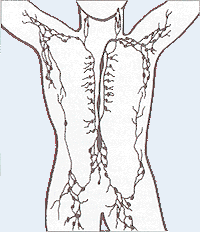Lymph node

Lymph nodes are components of the lymphatic system. They are sometimes incorrectly called "Lymph glands", but they do not secrete anything and are therefore not glands. Lymph nodes act as filters, with an internal honeycomb of connective tissue filled with lymphocytes that collect and destroy bacteria and viruses. When the body is fighting an infection, these lymphocytes multiply rapidly and produce a characteristic swelling of the lymph nodes. Humans have approximately 500-600 lymph nodes. Clusters of lymph nodes are found in the underarms, groin, neck, chest, and abdomen.
Lymph nodes are bean-shaped and range in size from a few millimeters to about 1-2 cm in their normal state. They may become enlarged due to a tumor or infection. In some cases, they may feel enlarged due to past infections; although one may be perfectly healthy, one may still feel residually enlarged. The lymph node is surrounded by a fibrous capsule, and inside the lymph node the fibrous capsule extends to form trabeculae. Thin reticular fibers form a supporting meshwork inside the node. The concave side of the lymph node is called the hilum. The artery and vein attach at the hilum and allow blood to enter and leave the organ, respectively. The parenchyma of the lymph node is divided into an outer cortex and an inner medulla. The cortex is absent at the hilum.
The band of the cortex adjacent to the medulla is the deep cortex, also called the juxtamedullary cortex or paracortex. This layer is devoid of nodules. Formation of the deep cortex depends on the migration of T cells. Thus it is sometimes also called the thymus-dependent cortex. In comparison, the layer of the cortex that contains nodules is called the nodular cortex.
The medulla consists of cords of lymphatic tissue (medullary cords) separated by vessel-like spaces called medullary sinuses.
Lymph travels to the lymph node via afferent lymphatic vessels and drains into the node just beneath the capsule in a space called the subcapsular sinus. The subcapsular sinus drains into trabecular sinuses and finally into medullary sinuses. The sinus space is criss-crossed by the pseudopods of macrophages which act to trap foreign particles and filter the lymph. The medullary sinuses converge at the hilum and lymph then leaves the lymph node via the efferent lymphatic vessel.
Lymphocytes, both B cells and T cells, constantly circulate through the lymph nodes. They enter the lymph node via the bloodstream and may cross the wall of the bloodvessel by the process of diapedesis. The B cells migrate to the nodular cortex and medulla, and the T cells migrate to the deep cortex.
When a lymphocyte recognizes an antigen, B cells become activated and migrate to germinal centers. When antibody-producing plasma cells are formed, they migrate to the medullary cords. Stimulation of the lymphocytes by antigens can accelerate the migration process to about 10 times normal, resulting in characteristic swelling of the lymph nodes.

The spleen and tonsils are large lymphoid organs that serve similar functions to lymph nodes, though the spleen filters out blood cells rather than bacteria or viruses.
Lymph nodes of the head and neck
Anterior cervical
These nodes, both superficial and deep, lie above and beneath the sternocleidomastoid muscles. They drain the internal structures of the throat as well as part of the posterior pharynx, tonsils, and thyroid gland.
Posterior cervical
These nodes extend in a line posterior to the sternocleidomastoids but in front of the trapezius, from the level of the mastoid bone to the clavicle. They are frequently enlarged during upper respiratory infections.
Tonsillar
These nodes are located just below the angle of the mandible. They drain the tonsillar and posterior pharyngeal regions. DON IS A LOSER
Sub-mandibular
These nodes run along the underside of the jaw on either side. They drain the structures in the floor of the mouth.
Sub-mental
These nodes are just below the chin. They drain the teeth and intra-oral cavity.
Supraclavicular
These nodes are in the hollow above the clavicle, just lateral to where it joins the sternum. They drain a part of the thoracic cavity and abdomen. Virchow's node is a left supraclavicular lymph node which receives the lymph drainage from most of the body (especially the abdomen) via the thoracic duct and is thus an early site of metastasis for various malignancies.
Lymph nodes of the arm
These drain the whole of the arm, and are divided into two groups, superficial and deep. The superficial nodes are supplied by lymphatics which are present throughout the arm, but are particularly rich on the palm and flexor aspects of the digits.
Superficial lymph glands of the arm

These comprise the:
- supratrochlear glands, situated above the medial epicondyle of the humerus, medial to the basilic vein. They drain the C7 and C8 dermatomes.
- deltoideopectoral glands, situated between the pectoralis major and deltoid muscles inferior to the clavicle.
Deep lymph glands of the arm

These comprise the axillary glands, which are 20-30 individual glands and can be subdivided into:
- lateral glands
- anterior or pectoral glands
- posterior or subscapular glands
- central or intermediate glands
- medial or subclavicular glands
